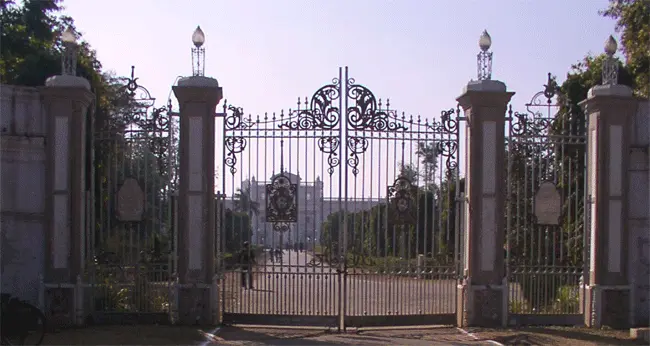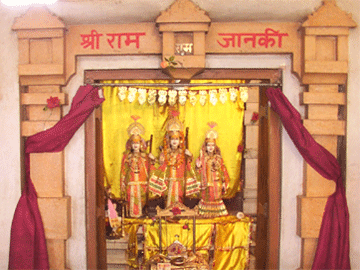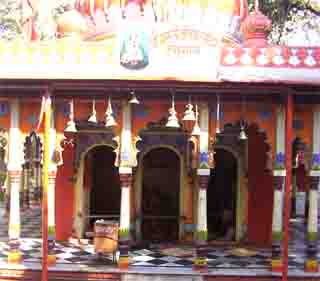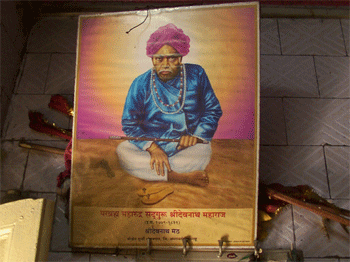
Gwalior
During the eighth century AD Suraj Sen, the chieftain of the place was struck by a mysterious deadly disease and was cured by the saint Gwalipa. As a tribute the chieftain had named the place after the saint, hence the place had come to be known as Gwalior. Many dynasties had ruled the place, each one of them leaving behind their stamp, memories, and monuments of their rule.
The city is centered around the fortress, one of the most formidable in India, built on the top of the isolated rock measuring about two and a half KM in length, about a KM in width, and with a maximum height of 100 M. The present city could broadly be divided into three, namely Morar, Lashkar (Lashkar in the Persian language means army or camp), and Old City.
Morar, Lashkar & Old city
 Morar, formerly a separate town, lies three miles east of the old city. This former British military
cantonment was restored to the Sindhias in 1886 after troops at Morar were withdrawn to Jhansi. In the
Revolt of 1857, Morar was the scene of the most serious uprising in Central India.
Morar, formerly a separate town, lies three miles east of the old city. This former British military
cantonment was restored to the Sindhias in 1886 after troops at Morar were withdrawn to Jhansi. In the
Revolt of 1857, Morar was the scene of the most serious uprising in Central India.
Lashkar is derived from the Persian Lashkar, meaning army, or camp, as it was originally the camp, and later the permanent capital, of Sindhia at Gwalior. Jivaji Chowk is the central focus of Lashkar.
The old city of Gwalior is of considerable size and lies at the eastern base of the rock. The tomb of Mian Tansen, a great singer and one of the 'Nine Jewels' of Akbar's court is situated here. Close to the heart of the city is the splendid Jai Vilas Palace, patterned on the French Palace of Versailles.
Gwalior under the Sindhia
The Scindia Dynasty hails from Kanherkheda, near Satara, in present-day Maharashtra. Members of the family joined the Maratha forces under the Chhatrapati Maharajas Shivaji the Great, Shambhaji, and Rajaram, serving with valour and distinction in several battles. The family reached the first ranks of the Maratha hierarchy under Ranoji Scindia, a gifted military commander under whose leadership Malwa was conquered. The great fortress of Gwalior, the notorious prison of the Mughals, fell to his forces for the first time in 1738.
Sri Jothiraditya Scindia had performed the religious rites for his father and after the thirteenth-day ceremony, the first 'sub karya' he had done was to visit this temple on the 12th of October 2001 and take the blessings of the Lord Sankata Mochan Hanuman.
Ranoji Scindia established his capital at Ujjain in 1731; which remained their capital till 1810. His successor Mahadji Rao Scindia seized Gwalior from the Raja of Gohad in 1765. His successor Daulat Rao Scindia moved the Sindhia capital to Lashkar in Gwalior during 1810. The Sindhia state of Gwalior became a major regional power in the latter half of the eighteenth century; they figured prominently in the three Anglo-Maratha Wars, held sway over many of the Rajput states, and conquered the state of Ajmer. After the defeat of the allied Maratha states by the British in the Third Anglo-Maratha War of 1818, the Scindia were forced to accept local autonomy as a princely state within British India and to give up Ajmer to the British. The Scindia family ruled Gwalior until India's independence from the United Kingdom in 1947 when Maharaja Jiyajirao Scindia acceded to the Government of India. Gwalior was merged with several other princely states to become the new Indian state of Madhya Bharat.
The tradition of worship of Lord Maruti
The rich royal remains of this dynasty are still spreading their fragrance in the city of Gwalior. The Scindias with Maratha background and followers of Chhatrapati Maharajas Shivaji the Great have also brought with them the rich tradition of worshiping Lord Maruti (Hanuman) as was done by the Guru Samart Ramdas, the Guru of Chhatrapati Maharajas Shivaji the Great.
Temple for Lord Hanuman in the Gwalior Palace complex
 Jai Vilas Palace is the royal seat of the Scindia family. Even now the portion of the palace is
serving as the residence of the Scindias. The splendid Jai Vilas Palace, patterned on the French
Palace of Versailles, is located at the heart of the city. No tourist to the city could afford to miss
visiting this place. The palace complex has three entrances, as you move from south to north on the
road leading to Moti Mahal you will come across these three gates leading to the Jai Vilas Palace. The
first one which is just opposite to Jiwaji Club of Badminton (which was called 'gend-ghar'
during the state period) will lead you to the museum maintained by the erstwhile royal family. If you
proceed further on the road that leads you to Moti Mahal which houses presently many Government
departments, the second entrance to the palace known by the name 'Rani Mahal Dwar' can be seen.
The present Scindia family enters the Jai Vilas Palace using this entrance. Further down is the 'main
entrance' which was used in the olden days, but is presently used only occasionally. Just opposite
this artistically made main gate, is located the temple for Lord Maruti, adjacent to the park, which
used to be a cricket ground during the State period.
Jai Vilas Palace is the royal seat of the Scindia family. Even now the portion of the palace is
serving as the residence of the Scindias. The splendid Jai Vilas Palace, patterned on the French
Palace of Versailles, is located at the heart of the city. No tourist to the city could afford to miss
visiting this place. The palace complex has three entrances, as you move from south to north on the
road leading to Moti Mahal you will come across these three gates leading to the Jai Vilas Palace. The
first one which is just opposite to Jiwaji Club of Badminton (which was called 'gend-ghar'
during the state period) will lead you to the museum maintained by the erstwhile royal family. If you
proceed further on the road that leads you to Moti Mahal which houses presently many Government
departments, the second entrance to the palace known by the name 'Rani Mahal Dwar' can be seen.
The present Scindia family enters the Jai Vilas Palace using this entrance. Further down is the 'main
entrance' which was used in the olden days, but is presently used only occasionally. Just opposite
this artistically made main gate, is located the temple for Lord Maruti, adjacent to the park, which
used to be a cricket ground during the State period.
Maruti Mandir
 The original temple for Lord Maruti had been established during Sri Mahadji Rao Scindia's time
somewhere near 1779 and further strengthened during Sri Daulat Rao Scindia's period. The main deity of
Lord Maruti had been installed by His Holiness Param Braham Maha Rudhr Sat Guru Sri Sri Dev Nathji of
Devnath Mutt, Surji Anjan Goan, Amaravati District, Maharashtra. The prana pradhista of the
Lord Maruti was done by this holy saint. It is the tradition of the Scindias to take the blessings of
the Lord Maruti, before venturing out for the day's routine. Hence this Maruti mandir was built just
opposite the main entrance of the Jai Vilas Palace. Today though the Scindias do not visit this temple
every day, the tradition of visiting this temple by the royals is still in practice. After the death
of Sri Madhav Rao Scindia his son Sri Jothiraditya Scindia performed the religious rites for his
father after the thirteenth-day ceremony, the first 'sub karya' he had done was to visit this
temple on the 12th of October 2001 and took the blessings of the Lord Sankata Mochan Hanuman.
The original temple for Lord Maruti had been established during Sri Mahadji Rao Scindia's time
somewhere near 1779 and further strengthened during Sri Daulat Rao Scindia's period. The main deity of
Lord Maruti had been installed by His Holiness Param Braham Maha Rudhr Sat Guru Sri Sri Dev Nathji of
Devnath Mutt, Surji Anjan Goan, Amaravati District, Maharashtra. The prana pradhista of the
Lord Maruti was done by this holy saint. It is the tradition of the Scindias to take the blessings of
the Lord Maruti, before venturing out for the day's routine. Hence this Maruti mandir was built just
opposite the main entrance of the Jai Vilas Palace. Today though the Scindias do not visit this temple
every day, the tradition of visiting this temple by the royals is still in practice. After the death
of Sri Madhav Rao Scindia his son Sri Jothiraditya Scindia performed the religious rites for his
father after the thirteenth-day ceremony, the first 'sub karya' he had done was to visit this
temple on the 12th of October 2001 and took the blessings of the Lord Sankata Mochan Hanuman.
The Temple complex
This temple for Lord Maruti had been established by the Scindia dynasty and is south-facing. As you enter the temple complex to the left (west) is the main temple. The temple of Lord Maruti is south-facing and just opposite this main mandir is the for Lord Ram. These two mandirs are separated by a big 'angan', where the devotees can sit and meditate. The mandir of Lord Ram is north-facing and the sannidhi of Lord Ram, Janaki, and Luxman is facing Lord Maruti. On the two sides of Lord Ram's sannidhi is sannidhi for Lord Krishna, Radha, and Lord Vishnu, Laxmi. There are two separate sannidhis for Lord Ganesha and Devi Kali. All these are later additions to the main Maruti mandir.
Maruti Sri Sankata Mochan Hanuman
The Lord Sri Sankata Mochan Hanuman installed by His Holiness Param Braham Maha Rudhr Sat Guru Sri Sri Dev Nathji is not a sculptured one but curved by nature (swayambhuhu). The Lord here is south facing and a 'yathur muki' Hanuman blessing His devotees with 'poorna drishti'. The Lord's right hand is seen in 'abhya mudra' and His left hand is resting on His hips. There is Lord Shiva in linga Roopa since Lord Maruti is a 'Rudhra-avatar'.
Location of the temple: "Sankat Mochan Hanumaan Mandir, Gwalior M.P"
Experience
Next time when you are around Gwalior do not miss to have darshan of this all-powerful Rudhra-avathara Sri Sankata Mochana Hanuman of the Maruti Mandir near Jai Vilas Palace and bring with you esteem and confidence for your endeavors and life.
SRI HANUMAN THINKS DIFFERENTLY, THINKS FAST
THINKS AHEAD AND ACTS FOR SURE
Ed [July 2008]
Updates: [Jan 2025]
* Author works for MP Police, Gwalior
